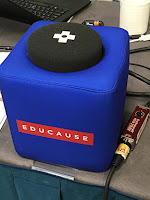 |
| Lizard on the side of the road |
And, this was my first Educause Connect - a conference that is even more than the annual event focused on fostering networking and creating interactive sessions to engage the audience with the content and with others who are grappling with similar challenges.
First session: Ball State University's Kyle Parker showed us the thought process and the possibilities that various sources of data can provide. He gave us a set of cards, each representing a different variable (student, location, LMS, institutional data and a wild card) and the goal was for us to come up with scenarios that would combine these cards into different data sets to show students more options for student success.
 |
| Cards with variables |
Imagine the possibilities, though -- student walks by the Wellness Center and gets reminded, because there is a hole in the calendar, that a spinning class is about to start.
Student walks by the library and gets a note that an exhibit is going on related to a class she is in.
Student is at home and gets a note that the bus is on the way, just in time for first class.
Second session: Innovation at Every Step, organized by Karlis Kaugars (SUNY College at Oneonta, and Somahy Kim Wu (U of North Carolina Charlotte), focused us on being innovative and, more importantly, on strategic considerations to sell an innovation -- what stakeholders do you need to worry about? What needs to let go if you want to start something new? How is the innovation aligning with institutional values, institutional distinction, and individual values? The most difficult question was probably what we could stop doing, providing to our end users, and no one would miss it - because that is where money and resources can be saved.
 |
| throwable microphone |
Third session: The Tools to Learn: Classroom Technology Section, was presented by Paul Stoll, Arizona State, and James Crawford, Lone Star College System. Its focus was on discussing options for classroom technologies and showing the spectrum for the participants to appreciate.
After lunch we moved into the poster sessions, where I was presenting on the way Auburn collaborates to implement change across multiple university units:
 |
| Poster on collaboration at Auburn University |
And, as a nice surprise, Daniela Marghitu, from our Computer Science Department, was also presenting her poster on Leveraging University IT Resources toward Enhancing IT Courses, showing how she is using Office365 and its resources through the university to give students the skills to work effectively with Office applications.
 |
| sticky note activity on collaboration |
The afternoon session reminded us how important, essential, and necessary digital accessibility is -- to quote the presenters Andrew Graf from TeamDynamix and Harriette Spiegel, U of Tennessee at Martin, digital accessibility is the wheelchair ramp for online content, and wheelchair ramps make all of our lives easier.
The presentation reminded us of the key laws we need to be aware of, the 1973 Rehabilitation Act, section 504, the 1990 Americans with Disability Act (ADA), and 1998s Section 508.
For any of us who put content online, whether in a blog, in a learning management system, or through other online tools, we need to add best practices to our work. Auburn University's learning management system, for example, automatically uses the name of the image file as its alt tag - so you don't have to worry about adding this information, but you do have to remember to give your image file a meaningful name.
Besides the alt tag for images, also consider using Headings and Styles as a screen reader will be able to guide a blind person more effectively through a text with these than with headlines that are simply bolded or set for a large font.
Everyone has the right to be able to access information -- it is the law.
I am wondering in what classes it makes sense to add the discussion about universal design and accessibility - ideas?
For the university, this also means that we need to demand from online services and tools, and from our software vendors that their products follow universal design. I believe we now have a mechanism in place at Auburn that will ensure we purchase digital technologies with this consideration in mind.
Final session: Preparing the Enterprise for the Cloud: Adoption Strategies, Balancing Stakeholders, and Satisfying Students, organized by Bob Flynn, Indiana University Bloomington, and Andrew Keating, Internet2, gided us through some role playing of different stakeholders at the table who are trying to figure out what cloud services for file sharing area feasible. Needless to say, we discovered that not one size/solution fits all -- so I am wondering if Auburn does not need to think about a second cloud storage solution that makes cross-institutional sharing of files and sharing or large files easier than what we currently have in place.
Finally, some pictures from Miami, both nature and architecture, old and new:
 |
| Banyan , one of the oldest in the country |
 |
| Freedom tower, a little younger than the tree |
 |
| highrises |
 |
| more higrises |
 |
| Cuban refugee |
 |
| yellow flowers |
Miami looks just like in the movies, and the idea that every day thousands of people move through this city to get onto one of the cruise ships lining up neatly in the harbor every morning is rather mind boggling. Next time, I need to spend some more time on museums, exhibits, and art.
No comments:
Post a Comment